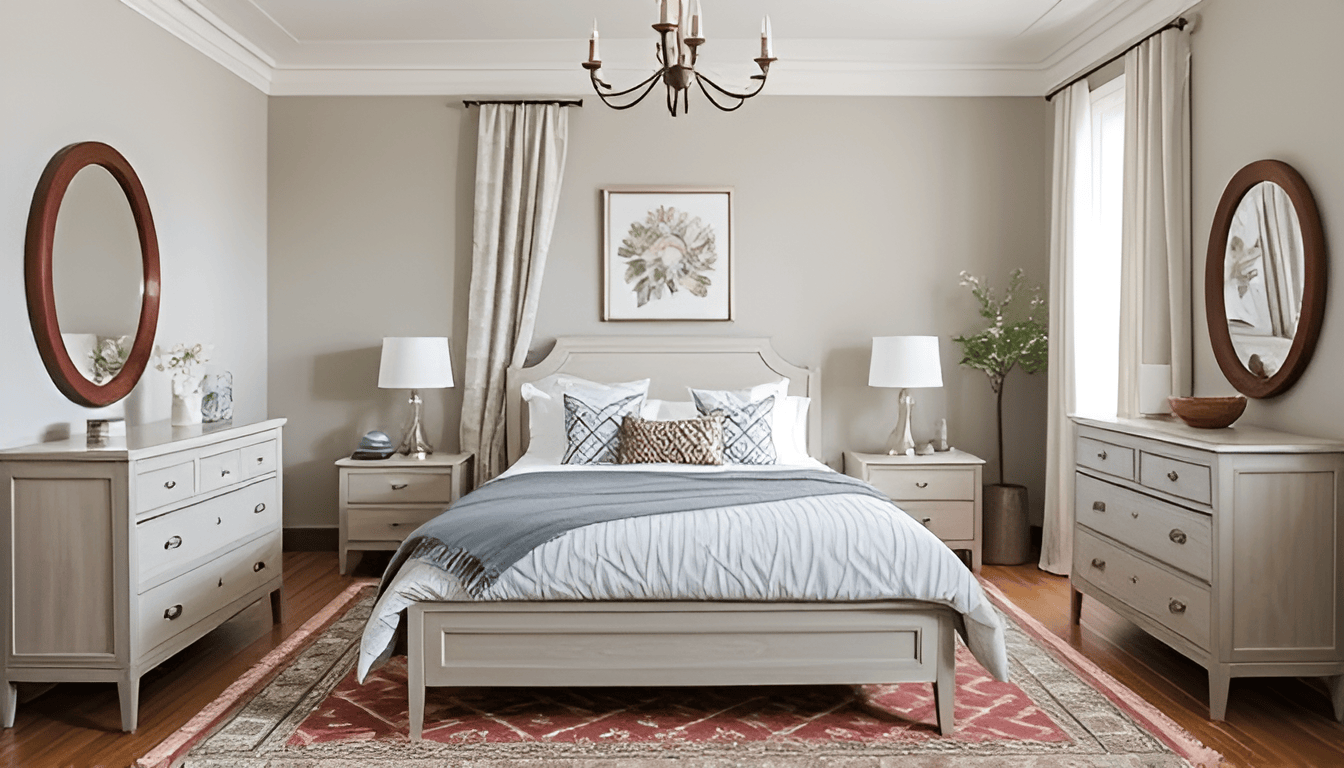Arranging bedroom furniture is an art that balances aesthetics, functionality, and comfort. A well-thought-out furniture arrangement not only makes the bedroom visually appealing but also enhances usability, providing a relaxing and comfortable space for rest. Whether you’re moving into a new home or simply revamping your current space, how you position your bed, dressing table, nightstands, and other pieces of furniture can significantly impact the overall feel and efficiency of your bedroom. This guide will explore essential tips for arranging bedroom furniture to create a harmonious and cozy environment.
1. Start with the Bed Placement
The bed furniture is the focal point of any bedroom, so its placement is crucial. The best spot for your bed depends on the size and layout of your room. In most cases, placing the bed against the longest wall works well as it provides symmetry and opens up the space. If your bedroom has windows or doors, avoid placing the bed directly in front of them, as this can block natural light and airflow. In Feng Shui, it’s also recommended to position the bed so that you can see the door from the bed, creating a sense of security.
Tips for Bed Placement:
- Consider the room size: In small rooms, placing the bed in a corner can free up space.
- Symmetry: Try to center the bed on the wall for a balanced look.
- Avoid blocking windows: Let natural light flow freely through the room.
2. Maximize Floor Space
One of the key challenges in bedroom arrangement is maximizing floor space. To achieve this, opt for multi-functional furniture, such as a bed with built-in storage or a foldable desk. Additionally, keeping furniture to the edges of the room and avoiding cluttered center spaces can create a more open and airy feel. Smaller bedrooms benefit from minimizing the number of bulky furniture pieces and focusing on essentials.
Tips for Maximizing Floor Space:
- Choose multi-purpose furniture: Beds with storage drawers, foldable desks, and wall-mounted shelves save space.
- Keep the center clear: Arrange furniture along the walls to make the room feel larger.
- Declutter regularly: Less furniture and fewer accessories create more breathing room.
3. Create Functional Zones
Creating functional zones within your bedroom can improve the room’s overall flow and usability. For instance, designate a corner for reading by placing a chair and floor lamp next to a bookshelf. Alternatively, a small vanity table near the window can serve as a dressing area. Having clear zones helps separate activities, making your bedroom feel organized and purposeful.
Tips for Creating Zones:
- Reading corner: Add a comfy chair, a side table, and a light source for a cozy reading spot.
- Dressing area: Use a vanity table and mirror near a natural light source for an ideal dressing zone.
- Work zone: If your bedroom doubles as a workspace, place a small desk in a quiet corner.
4. Balance the Room with Symmetry
Symmetry plays a significant role in furniture arrangement, especially in bedrooms. Pairing nightstands on either side of the bed, matching lamps, or identical dressers can create a balanced and calming environment. This symmetry enhances the visual appeal and makes the space feel more organized and harmonious.
Tips for Achieving Symmetry:
- Twin nightstands: Place identical nightstands on both sides of the bed for a polished look.
- Matching lamps: Add the same lamps on either side to frame the bed.
- Mirrored furniture placement: Arrange dressers or cabinets in symmetrical pairs to enhance balance.
5. Consider Traffic Flow
One of the most important aspects of bedroom furniture arrangement is ensuring proper traffic flow. Avoid placing furniture in pathways or in front of doors, which can obstruct movement. Maintain clear walking paths around the bed and to essential areas like closets and dressers. Leave at least 24 inches of space between the bed and walls or other furniture pieces to ensure easy movement.
Tips for Improving Traffic Flow:
- Avoid blocking doorways: Ensure doors can open fully without hitting furniture.
- Leave space around the bed: Keep enough clearance for easy access to the bed.
- Organize walking paths: Maintain clear routes to the closet, bathroom, and any other exits.
6. Prioritize Storage Solutions
Storage is an essential component of bedroom design, particularly if the space is small. Opt for furniture pieces that offer built-in storage, such as beds with drawers or headboards with shelves. Dressers, armoires, and wall-mounted storage solutions are also excellent ways to keep the room tidy without sacrificing space. Well-planned storage reduces clutter and ensures that everything has its place.
Tips for Adding Storage:
- Under-bed storage: Utilize the space under your bed with pull-out drawers or storage boxes.
- Vertical storage: Use tall dressers and shelves to maximize vertical space.
- Wall-mounted options: Floating shelves and cabinets save floor space while adding extra storage.
7. Choose the Right Nightstands
Nightstands serve as functional and decorative pieces in a bedroom. Choose nightstands that are proportionate to the size of the bed and the room. For smaller bedrooms, consider floating nightstands or wall-mounted shelves to save space. Ensure that nightstands offer enough surface area for essentials like lamps, books, or an alarm clock while not overwhelming the room.
Tips for Selecting Nightstands:
- Proportion matters: Choose nightstands that complement the size of your bed.
- Small spaces: Opt for floating nightstands or minimalist designs to save space.
- Storage: Select nightstands with drawers or shelves for added functionality.
8. Place Dressers Strategically
Dressers are bulky but essential bedroom pieces, so their placement should be strategic. A good spot for a dresser is along a wall that isn’t directly facing the bed or blocking doorways. For large bedrooms, placing the dresser opposite the bed or near the closet ensures easy access. In small rooms, opt for tall, narrow dressers to save floor space while maximizing storage.
Tips for Dresser Placement:
- Avoid blocking pathways: Place dressers against walls or in corners, leaving open space for movement.
- Opposite the bed: A dresser opposite the bed is both functional and visually appealing.
- Tall dressers: Use taller dressers in small rooms to save floor space.
9. Use Mirrors to Create Illusion of Space
Mirrors are an excellent tool for making small bedrooms appear larger. Placing a mirror opposite a window allows natural light to bounce around the room, brightening the space and making it feel more open. Floor-length mirrors also add verticality to the room and serve a dual purpose for both design and function.
Tips for Using Mirrors:
- Opposite windows: Place mirrors to reflect natural light and create an airy atmosphere.
- Full-length mirrors: Use tall mirrors to add height and openness to the room.
- Mirrored furniture: Consider furniture with reflective surfaces to enhance light distribution.
10. Incorporate Personal Touches
Your bedroom should reflect your personality, so don’t be afraid to add personal touches. Incorporate items like artwork, decorative pillows, or family photos that resonate with your style. However, avoid overcrowding the room with too many accessories, which can make the space feel cluttered.
Tips for Adding Personal Style:
- Wall art: Use framed prints, posters, or photos to add character.
- Bedding: Choose colorful or patterned bedding that complements your room’s theme.
- Sentimental items: Incorporate personal décor, but keep it balanced to avoid clutter.
11. Opt for Minimalist Design in Small Rooms
In small bedrooms, a minimalist approach works best. Stick to the essential furniture pieces and avoid overwhelming the room with unnecessary items. Opt for sleek, modern furniture that has clean lines and is proportionate to the room size. Keeping the design minimal helps the room appear more spacious and calming.
Tips for Minimalist Design:
- Stick to essentials: Only include must-have furniture, such as the bed, nightstands, and a dresser.
- Sleek furniture: Choose streamlined pieces that fit the room’s scale.
- Neutral tones: Use light colors and simple décor to maintain a serene and open space.
12. Lighting Matters
Lighting can transform the atmosphere of a bedroom. Layered lighting, which includes a mix of ambient, task, and accent lighting, helps create a warm and inviting space. Use bedside lamps for reading, overhead lights for general illumination, and sconces or pendant lights for decorative purposes. Lighting should be both functional and aesthetic, providing enough brightness for activities without overwhelming the room.
Tips for Effective Lighting:
- Layered lighting: Use a combination of overhead lights, lamps, and accent lighting.
- Dimmers: Install dimmer switches to control the room’s brightness and mood.
- Functional lamps: Place reading lamps on nightstands for easy access.
13. Ensure Furniture Proportions Fit the Room
One of the most common mistakes people make when arranging bedroom furniture is choosing pieces that are either too large or too small for the space. Oversized furniture can overwhelm a room, while undersized pieces can make it feel empty and disjointed. Always measure your room before purchasing furniture and ensure the proportions of each item complement the size of the space.
Tips for Proportionate Furniture:
- Measure first: Always take room measurements before buying furniture.
- Scale: Ensure that all furniture pieces are in harmony with the room size.
- Avoid overcrowding: Less is often more when arranging furniture in smaller bedrooms.


